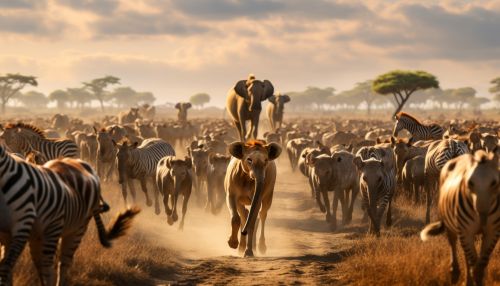Migration (biology)
Introduction
Migration in the biological context refers to the regular, often seasonal, movement of all or part of an animal population to and from a given area. The phenomenon is found in all major animal groups, including birds, mammals, fish, reptiles, amphibians, insects, and crustaceans. The trigger for the migration may be local climate, local availability of food, the season of the year or for mating reasons.


Types of Migration
Complete Migration
Complete migration is where all individuals within a population migrate, travelling away from their habitat for a particular purpose. This is most common in birds, where entire populations may migrate thousands of kilometres between their breeding habitat and their non-breeding habitat.
Partial Migration
Partial migration is where only a subset of the population migrates. This can occur in several ways. For example, in some species, only the juvenile individuals migrate (a phenomenon known as "natal dispersal"), while the adults remain resident. In other species, only the females migrate, leaving the males behind.
Differential Migration
Differential migration is a type of partial migration where different classes of individuals within the same population migrate different distances. For example, in some bird species, the adult males migrate further south than the females and juveniles, presumably to secure the best breeding territories.
Irruptive Migration
Irruptive migration, also known as nomadism, is a type of migration in which the timing and direction of migration vary from year to year, depending on environmental conditions. This is common in some insect and bird species, which may breed in a different location each year depending on food availability.
Mechanisms of Migration
Migratory animals use a variety of methods to navigate during migration, including the sun, stars, the Earth's magnetic field, and their own innate sense of direction known as "dead reckoning". Some species, such as pigeons and sea turtles, are able to navigate using both magnetic and olfactory cues.
Timing
The timing of migration can be controlled both by genetic factors and by environmental cues. For example, changes in day length can trigger the onset of migration in many species. Other environmental cues that may trigger migration include changes in food availability, temperature, and population density.
Impact of Migration
Migration has significant ecological and evolutionary impacts. It allows species to exploit different environments at different times of the year, enables them to avoid predators and harsh weather conditions, and can play a key role in population dynamics and species interactions.
Threats to Migration
Human activities pose a number of threats to migratory species. Habitat loss and fragmentation, climate change, pollution, and overexploitation are all factors that can disrupt migration patterns and have serious impacts on migratory species and the ecosystems they inhabit.
Conservation of Migratory Species
Conservation efforts for migratory species must take into account the full range of habitats that these species use throughout their migratory cycle. This often requires international cooperation, as migratory species often cross national borders during their migrations.
